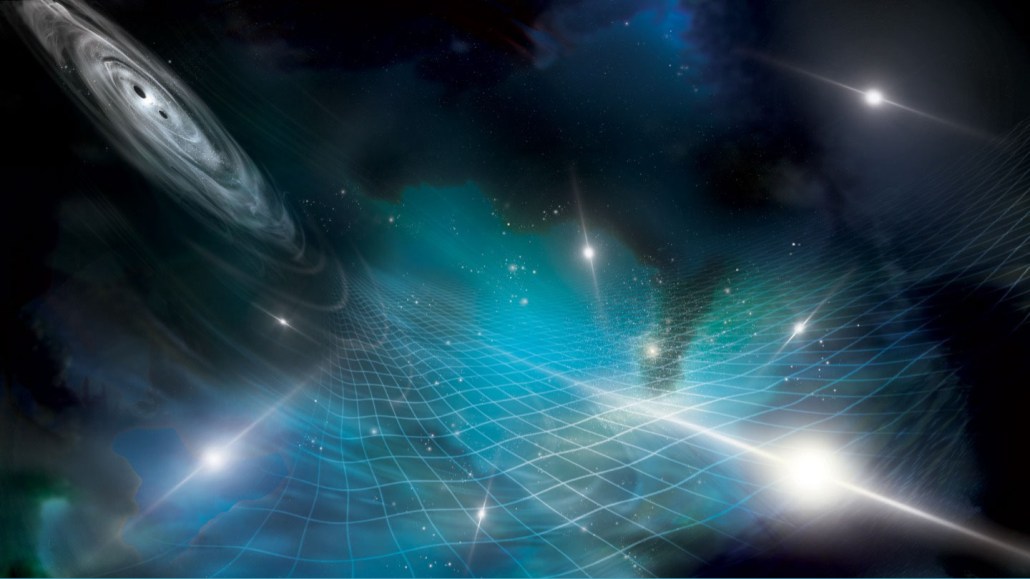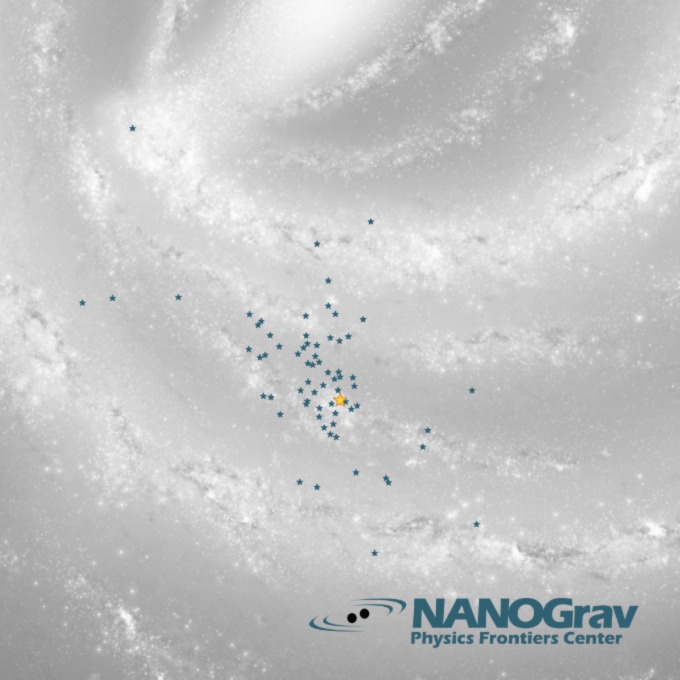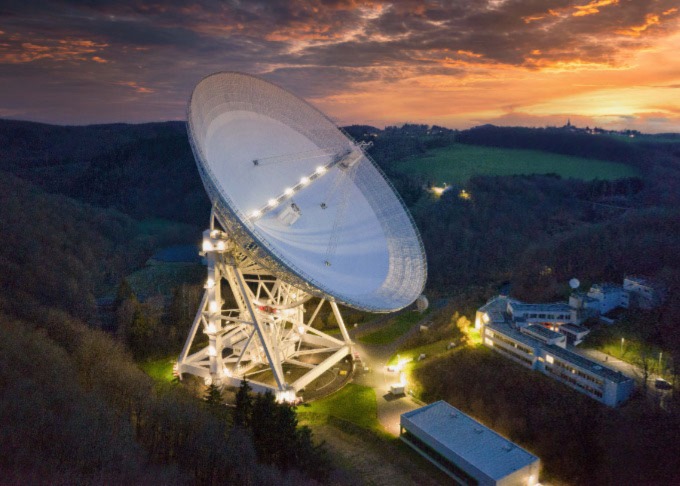Newfound gravitational waves may be from the biggest black holes in the universe
Observations of dead stars hint at ripples in spacetime that are light-years long

Dead stars called pulsars (illustrated) emit beams of radio waves. As pulsars spin, their beams of radio waves sweep past Earth like clockwork. Gravitational waves from supermassive black-hole pairs (upper left) are thought to ripple the fabric of spacetime, subtly altering the pulsars’ timing.
Aurore Simonnet/Sonoma State University, NANOGrav
Share this:
- Share via email (Opens in new window) Email
- Click to share on Facebook (Opens in new window) Facebook
- Click to share on X (Opens in new window) X
- Click to share on Pinterest (Opens in new window) Pinterest
- Click to share on Reddit (Opens in new window) Reddit
- Share to Google Classroom (Opens in new window) Google Classroom
- Click to print (Opens in new window) Print
Scientists may have just found the longest gravitational waves yet.
Gravitational waves are ripples in the fabric of spacetime. Kicked up by massive objects, they roll through the universe like water waves on the surface of the ocean. The newfound gravitational waves are light-years long. That means it would take years for light to travel the distance of a single ripple.
What’s more, these waves wash through the universe nonstop. They constantly jostle Earth — and the rest of our galaxy.
Pairs of huge supermassive black holes are thought to trigger these waves. Those black-hole behemoths sit at the centers of galaxies. Scientists think that when two galaxies collide, their black holes pair up and orbit each other. This action could churn up those gravitational waves in spacetime.
Indeed, across the universe, galaxies often mingle and merge. As they do, scientists had suspected their supermassive black holes would orbit each other. In the process, these black holes would give off gravitational waves. In fact, they should pump out waves nonstop for millions of years. Many supermassive-black-hole pairs in the many merging galaxies across the cosmos would send out their spacetime ripples at once. This, scientists thought, should create a constant mishmash of very long gravitational waves.
On June 28, researchers shared the first clear evidence of such a background of gravitational waves. Those data came from several teams around the world.
Scientists must confirm that the newly spotted waves are real — and that they do come from pairs of huge black holes. But if so, “it’s miraculous,” says Meg Urry. She’s an astrophysicist at Yale University. That’s in New Haven, Conn.
Confirming the new findings would offer the first proof that the biggest black holes in the cosmos can spiral into each other and merge. “It’s extremely interesting,” Urry says. The reason? “We have essentially no handle on what the most massive black holes are doing.”
Catching a new kind of wave
Since 2015, scientists have spotted lots of gravitational waves. Some have come from smashups between neutron stars. Others have come from colliding black holes. But the black holes in those collisions were small, by cosmic standards. Most were less than 100 times the mass of our sun. Their smashups created blips of gravitational waves that detectors on Earth felt for mere fractions of a second.
Those supermassive black holes thought to cause the newfound gravitational waves are entirely different beasts. Each can have the mass of millions or billions of suns.
“The Earth is just randomly bumping around on this sea of gravitational waves,” says Maura McLaughlin. She’s an astrophysicist at West Virginia University in Morgantown.
Compared to the gravitational waves seen before, “this is a very different sort of thing,” says Daniel Holz. This astrophysicist works at the University of Chicago, in Illinois. He and others have used the LIGO detector to spot gravitational-wave blips from small black-hole smashups.
To find waves from supermassive black holes required a whole new technique.
Peering at pulsars
For this new research, scientists looked to objects called pulsars. They’re spinning remnants of exploded stars. Like celestial lighthouses, pulsars emit beams of radio waves as they spin. Their beams sweep past Earth at regular intervals. Those flashing beams of radio waves are picked up, like the precise ticks of a clock, by telescopes on Earth.
Gravitational waves can stretch and squeeze the space between a pulsar and Earth. In that way, such ripples in spacetime could cause a pulsar’s “ticks” to reach Earth early or late. Scientists have now used this effect to search for the gravitational waves from supermassive black holes as they roll through space.
A project called NANOGrav has watched dozens of pulsars for 15 years. (NANOGrav is short for North American Nanohertz Observatory for Gravitational Waves.) The NANOGrav team now thinks it finally has evidence of gravitational waves from pairs of supermassive black holes. The team just shared its findings in Astrophysical Journal Letters.

“It’s really invigorating stuff,” says Michael Keith. He’s an astrophysicist at the University of Manchester in England. He’s also a member of the European Pulsar Timing Array, or EPTA.
The EPTA team spent an even longer time staring at pulsars — about 25 years. “We were starting to think maybe the signal is just so weak, we’ll never ever find it,” Keith says. But like NANOGrav, EPTA has now seen evidence for gravitational waves altering pulsar signals.
EPTA’s results have been accepted in the journal Astronomy and Astrophysics. The European group teamed up with researchers from the Indian Pulsar Timing Array to do the work. Teams from Australia and China have now shared evidence for gravitational waves from pairs of supermassive black holes, too.

It’s not over yet
Some scientists had thought that supermassive black holes in merging galaxies would never draw close enough to merge. In that case, they wouldn’t give off gravitational waves like the ones scientists think they have now observed.
“It’s actually been a sore spot for our field for many years,” Chiara Mingarelli says. Mingarelli is an astrophysicist on the NANOGrav team. She’s based at Yale University.
But if the new gravitational-wave signal is real, it seems to be stronger than expected. That suggests that supermassive black holes spiraling into each other are common. This, in turn, hints that mergers between such black holes also are common.
But none of the teams sharing new data say they have for sure detected gravitational waves from huge black-hole pairs. They just say they’ve found strong evidence for this. That’s because each of their observations comes with some uncertainty. In the future, the separate teams plan to join forces. Combining their data may help confirm the detection.
Still, even if the waves are real, it’s possible they don’t come from pairs of monster black holes. Such huge black holes appear to be the simplest explanation. Still, researchers can’t rule out a more exotic one. For example, the ripples might have arisen from the fast expansion of the universe just after the Big Bang.
Learning more about supermassive black holes is key to understanding the galaxies that host them. So whatever the source of the potential new gravitational waves, their future study is bound to have ripple effects.






